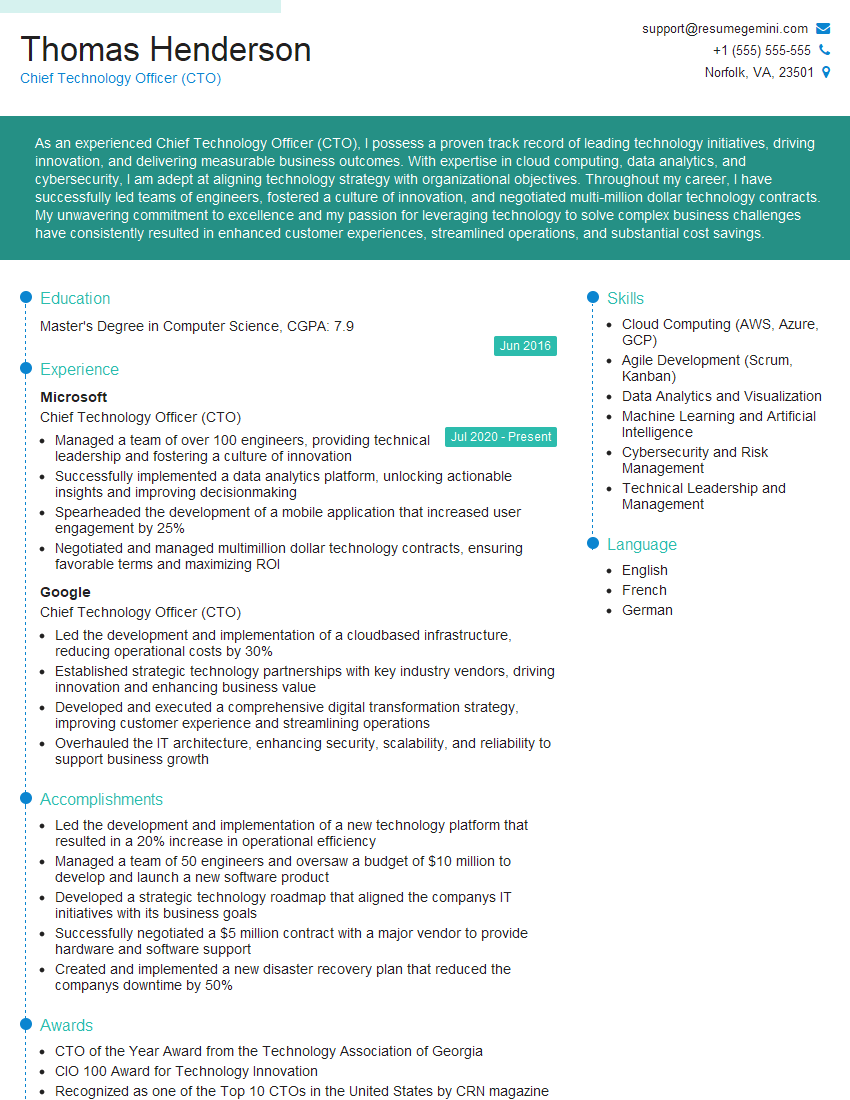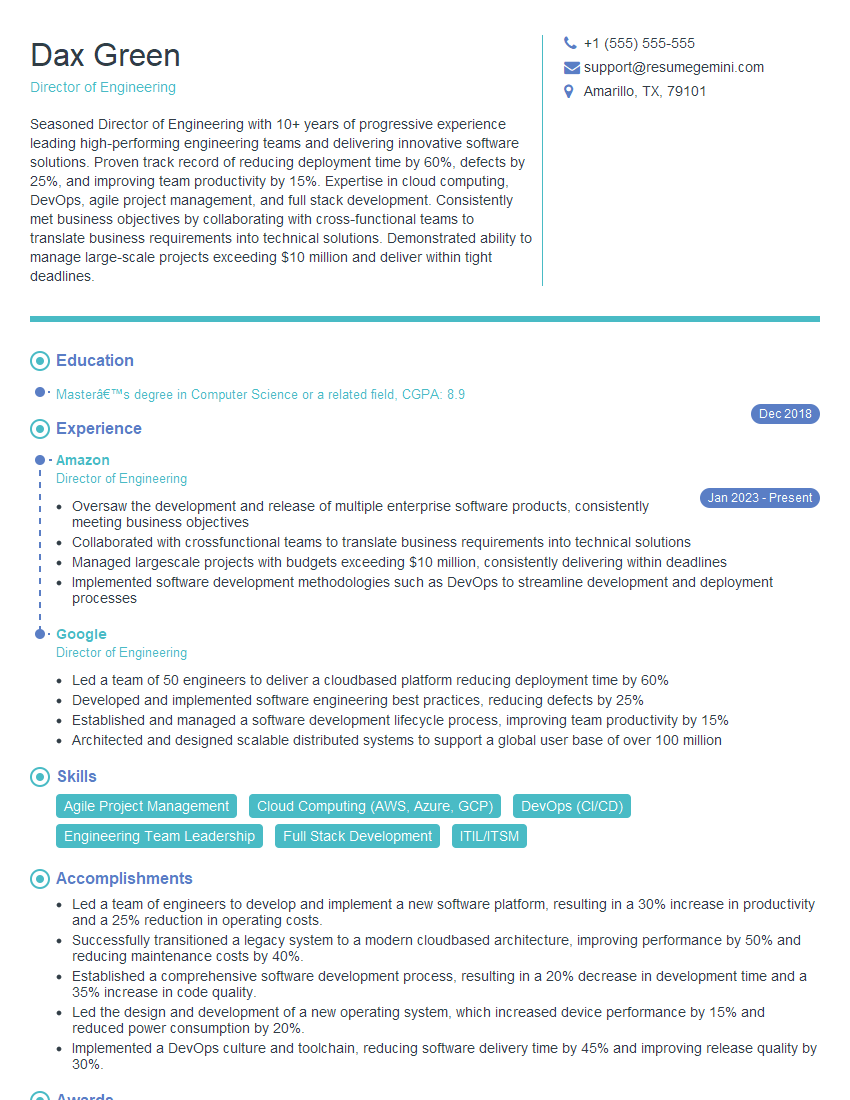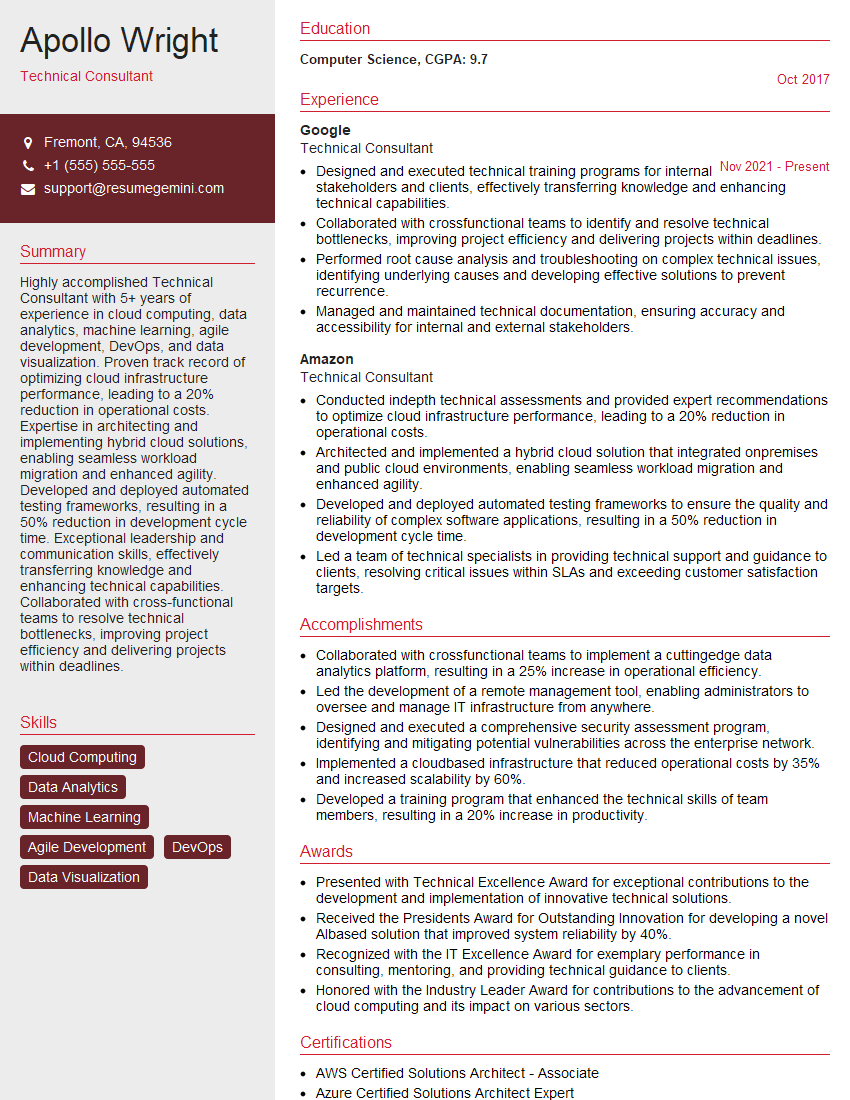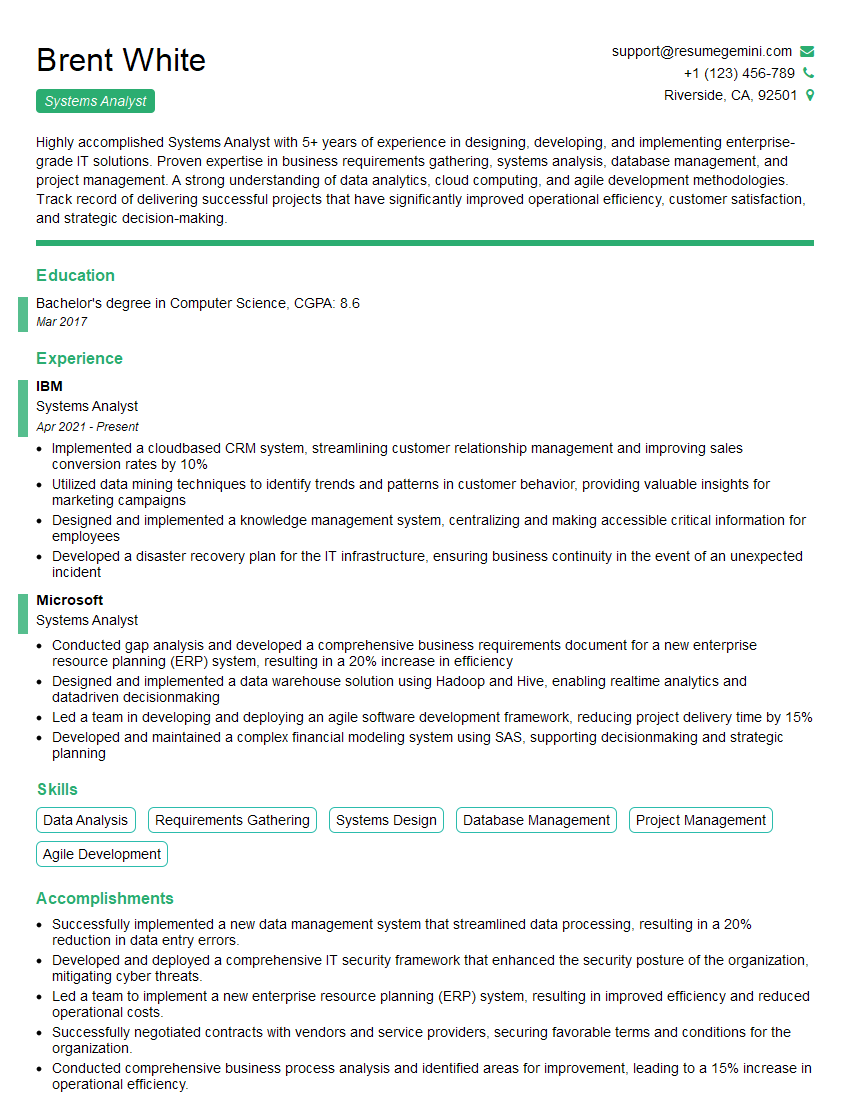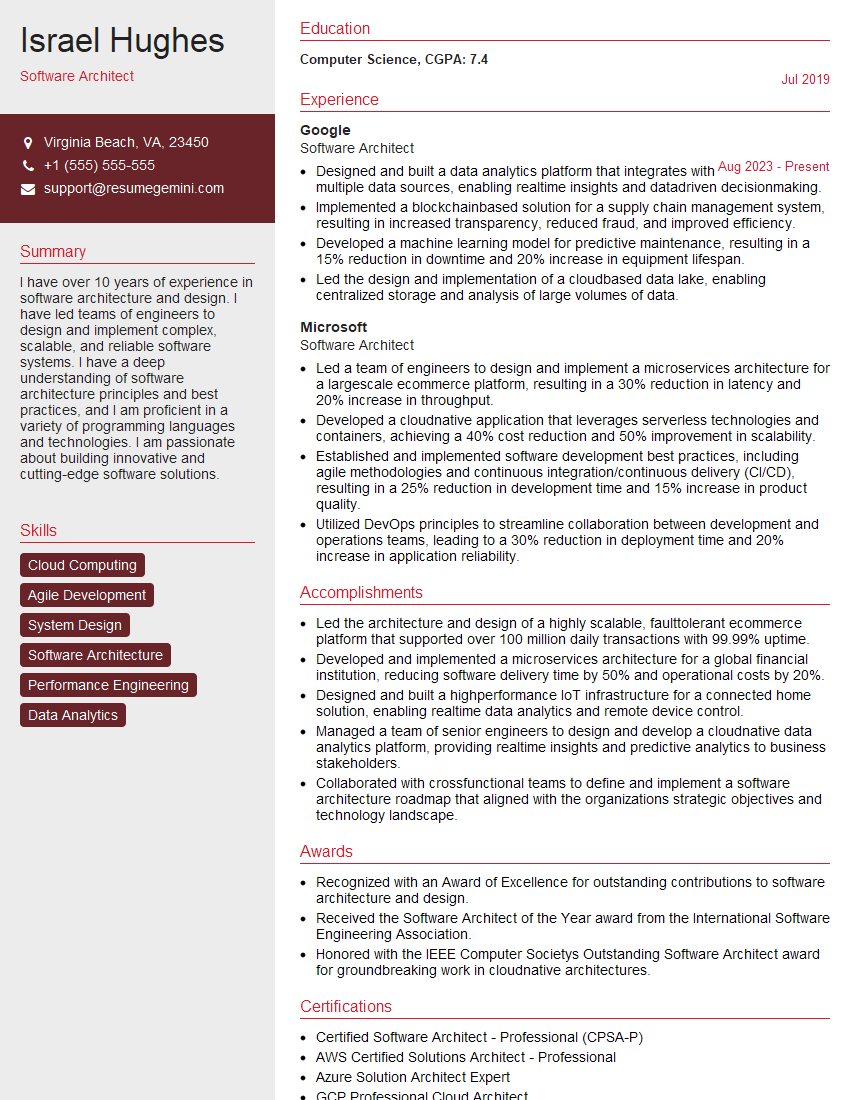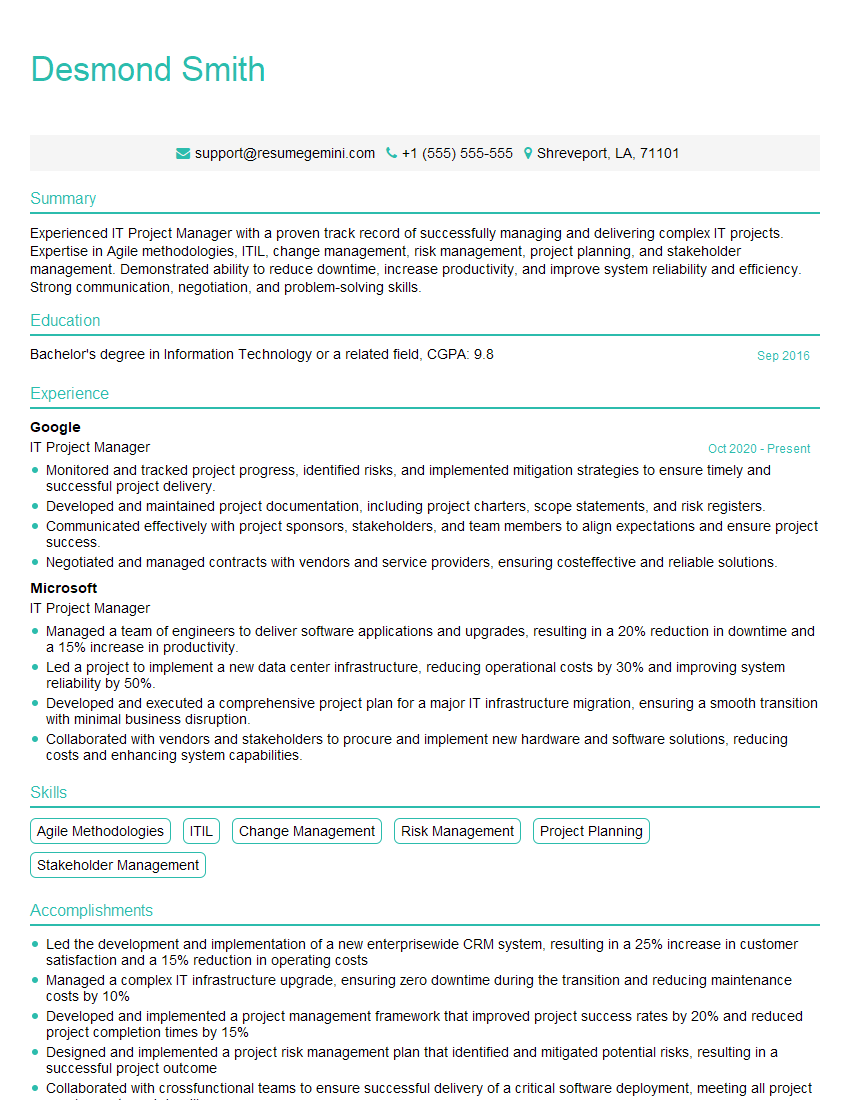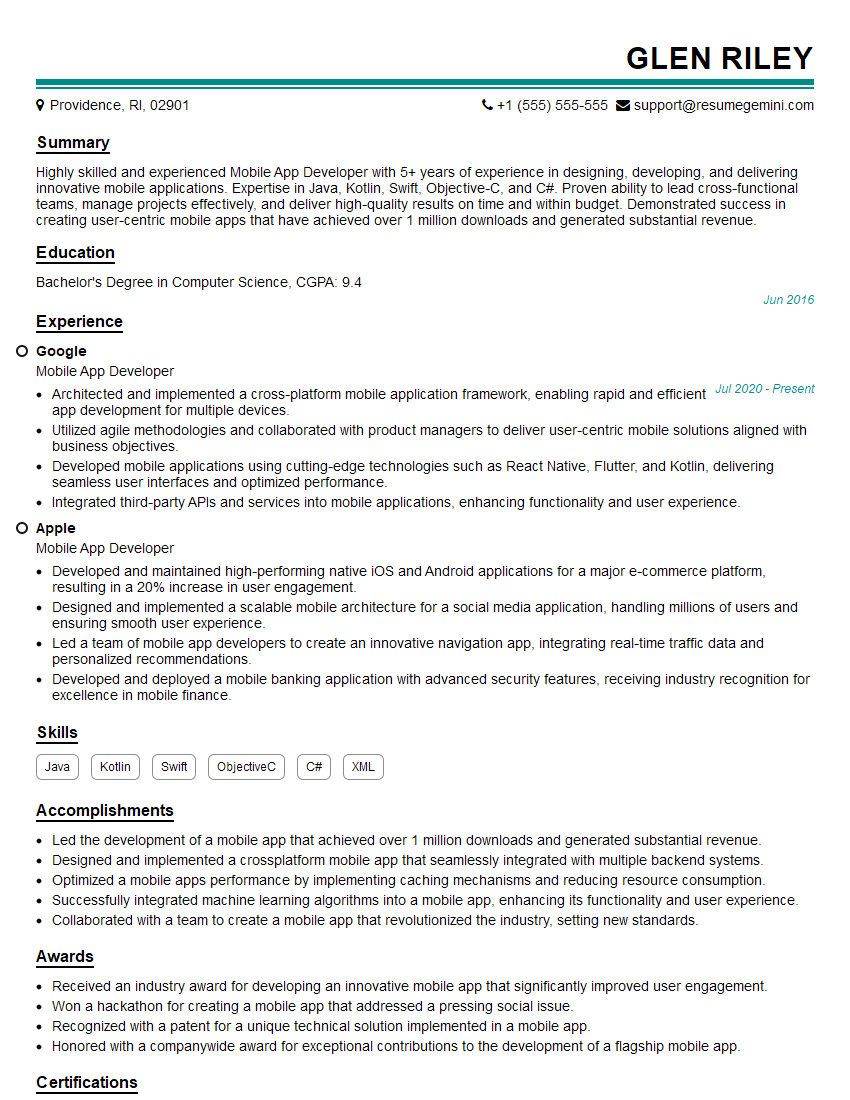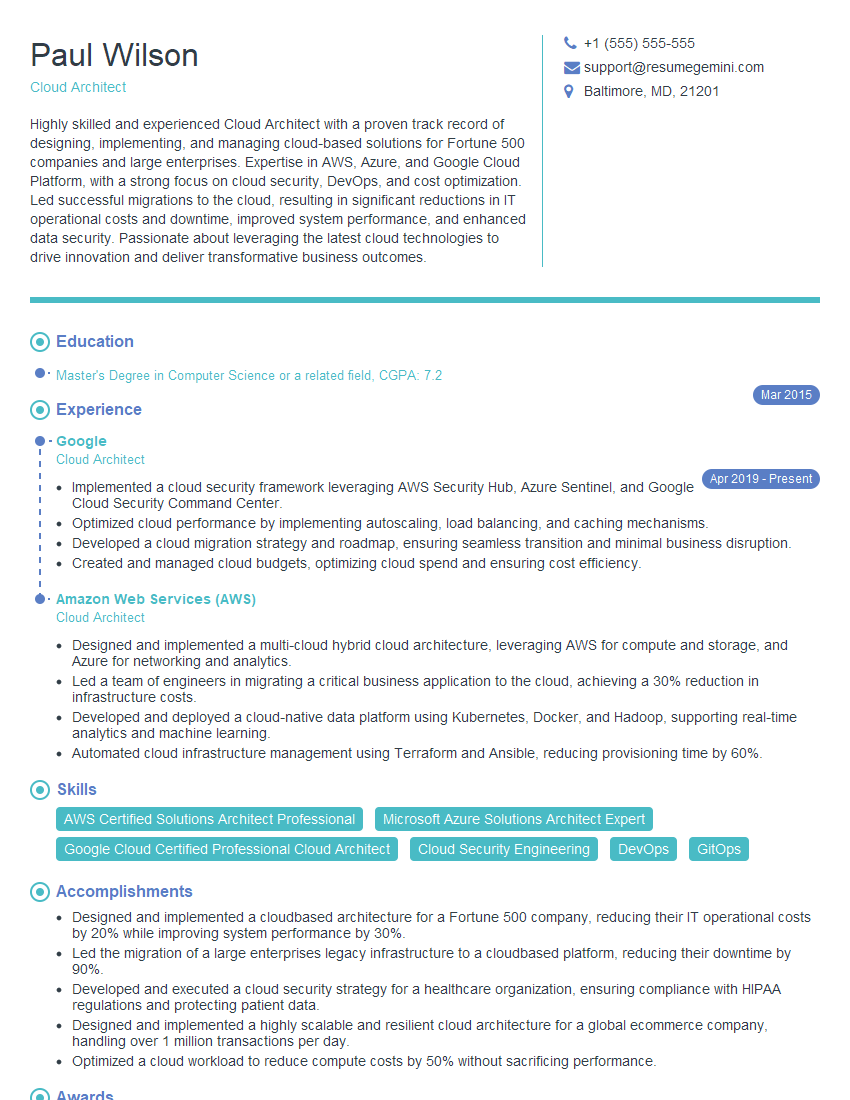Feeling uncertain about what to expect in your upcoming interview? We’ve got you covered! This blog highlights the most important Ability to adapt to changing technology and industry trends interview questions and provides actionable advice to help you stand out as the ideal candidate. Let’s pave the way for your success.
Questions Asked in Ability to adapt to changing technology and industry trends Interview
Q 1. Describe a time you had to learn a new technology quickly.
Learning new technologies quickly is crucial in today’s rapidly evolving digital landscape. It requires a blend of proactive learning, effective resource utilization, and a growth mindset.
For example, during a recent project involving the migration of a legacy system to a cloud-based infrastructure, we needed to implement serverless functions using AWS Lambda within a tight deadline. I wasn’t intimately familiar with Lambda beforehand, but I leveraged several resources: I started with AWS’s official documentation, followed tutorials on YouTube, and engaged in hands-on practice using the AWS Free Tier. I also collaborated with a colleague who had more Lambda experience. Within a week, I was proficient enough to contribute significantly to the project, writing, testing, and deploying several Lambda functions. This involved understanding concepts like event triggers, function handlers, and IAM roles. The key was a structured approach: focusing first on the core concepts, then tackling more advanced features progressively.
Q 2. How do you stay updated on industry trends?
Staying abreast of industry trends is an ongoing process, not a one-time task. My strategy involves a multi-pronged approach:
- Industry publications and blogs: I regularly read publications like TechCrunch, Wired, and industry-specific blogs relevant to my field. This provides high-level overviews of emerging technologies and their impact.
- Conferences and webinars: Attending industry conferences and webinars offers valuable insights directly from experts and allows networking with peers.
- Online courses and certifications: Platforms like Coursera, edX, and Udemy provide structured learning paths for new technologies and skills. Obtaining relevant certifications validates my competency and demonstrates commitment to continuous learning.
- Networking and mentorship: Engaging with colleagues, attending meetups, and seeking mentorship provides different perspectives and early access to emerging trends.
- Following key influencers: I follow thought leaders and experts on social media platforms like Twitter and LinkedIn, which provides a rapid stream of news and insights.
Q 3. What strategies do you use to adapt to new software or tools?
Adapting to new software or tools requires a systematic and iterative approach. My strategy involves:
- Understanding the fundamentals: I begin by understanding the core functionalities and purpose of the new tool. This usually involves reviewing documentation, tutorials, or online resources.
- Hands-on practice: Theory alone is not enough. I create small, self-directed projects to actively utilize the new tool. This helps me identify areas where I need more understanding.
- Identifying key features: Not all features are created equal. I prioritize learning the essential features that are most relevant to my work.
- Seeking feedback: I actively solicit feedback from peers or mentors on my usage of the new tool to identify areas for improvement.
- Continuous improvement: Mastering a new tool is a journey, not a destination. I continue to refine my skills through ongoing practice and exploration of advanced features.
For example, when our team adopted a new project management tool, I spent the first few days working through the tutorials, then created a sample project to test the different features. I also participated in a training session with the rest of the team, which allowed for shared learning and problem-solving.
Q 4. Explain your approach to managing unexpected technological changes in a project.
Unexpected technological changes require a calm, decisive, and collaborative approach. My strategy focuses on:
- Assessing the impact: The first step is to quickly assess the nature and scope of the change and its potential impact on the project timeline and deliverables.
- Communicating transparently: I communicate the change to the team promptly and transparently, providing context and outlining potential solutions.
- Identifying mitigation strategies: Depending on the nature of the change, I work with the team to identify potential mitigation strategies, which might involve adjusting the project timeline, reallocating resources, or adopting alternative technologies.
- Risk management: I work to identify and mitigate potential risks associated with the change, documenting these risks and associated mitigation plans.
- Continuous monitoring: After implementing the mitigation strategies, I continuously monitor the situation to ensure the project remains on track.
In one instance, a critical third-party API we were relying on experienced an unexpected outage. I immediately notified the team, assessed the impact on our deliverables, and explored alternative solutions. We ended up using a cached version of the data for the short term while the API was restored and documented this incident as a risk for future planning.
Q 5. How do you handle resistance to adopting new technologies within a team?
Resistance to new technologies is common, often stemming from fear of the unknown or discomfort with change. My approach involves:
- Understanding the resistance: First, I try to understand the root cause of the resistance through open communication and active listening.
- Demonstrating value: I showcase the benefits of the new technology through clear demonstrations, emphasizing how it can improve efficiency, productivity, or quality.
- Providing training and support: I offer comprehensive training and ongoing support to help team members learn and master the new technology.
- Addressing concerns: I proactively address any concerns or fears the team members may have, demonstrating that their input is valued.
- Incremental adoption: If necessary, I adopt an incremental approach, introducing the new technology in stages rather than all at once, allowing the team to adapt gradually.
For example, when introducing a new automated testing framework, I first addressed the team’s concerns about the learning curve. I then provided hands-on training and paired programming sessions to support them, and gradually phased in the use of the framework into our workflow.
Q 6. Describe a time you had to adapt to a significant change in your role or responsibilities.
Adapting to significant changes in roles and responsibilities is essential for career growth. I had a situation where my role shifted from primarily a hands-on developer to a team lead. This involved transitioning from individual contributions to managing a team, delegating tasks, providing mentorship, and handling project management responsibilities.
I approached this change proactively by seeking out training and mentorship on effective leadership techniques. I focused on developing my communication, delegation, and conflict-resolution skills. I also worked to build strong relationships within my team, fostering trust and collaboration. The success of this transition relied heavily on adapting my communication style, becoming more focused on delegation and strategic planning than on individual coding tasks. The result was a more efficient and collaborative team, and personal growth in leadership skills.
Q 7. How do you evaluate the potential impact of new technologies on your work?
Evaluating the potential impact of new technologies involves a thorough assessment process. I consider the following:
- Alignment with business goals: Does the new technology directly support or enhance our current strategic objectives?
- Cost-benefit analysis: What are the associated costs (implementation, training, maintenance) versus the potential benefits (increased efficiency, improved quality, cost reduction)?
- Risk assessment: What are the potential risks and challenges associated with adoption (technical issues, integration problems, resistance to change)?
- Feasibility: Is the technology compatible with our existing infrastructure and skillset?
- Scalability: Can the technology scale to meet future needs and growth?
For instance, before recommending the adoption of a new cloud-based platform, I thoroughly evaluated the associated costs, potential benefits, integration challenges, and training needs. I then prepared a detailed report summarizing my findings and recommendations for the management team.
Q 8. What are some resources you utilize to learn about emerging technologies?
Staying ahead of the curve in technology requires a multi-faceted approach to learning. I leverage a variety of resources, tailoring my approach based on the specific technology. For emerging trends in software development, I rely heavily on reputable online platforms like Coursera, edX, and Udacity, which offer structured courses and certifications from leading universities and industry experts. For more niche technologies or rapid advancements, I turn to publications like MIT Technology Review, IEEE Spectrum, and industry-specific blogs and newsletters. Podcasts, such as those focusing on AI or cybersecurity, are a great way to passively absorb information during commutes or downtime. Finally, attending industry conferences and webinars allows me to network with other professionals and gain firsthand insights from leading practitioners.
For example, when learning about the latest advancements in cloud computing, I might start with a Coursera course on AWS or Azure, supplement it with articles from the AWS blog or Azure documentation, and then attend a relevant conference to connect with experts in the field.
Q 9. How do you prioritize learning new skills in a fast-paced environment?
Prioritizing skill acquisition in a dynamic environment demands a strategic approach. I use a combination of methods: Firstly, I assess my current skills against future demands. This involves researching the industry roadmap and anticipating future skill needs. Secondly, I prioritize learning based on impact – focusing on skills that will provide the greatest return on my investment of time. This means prioritizing skills that are directly relevant to my current projects or that will open up significant new opportunities. Thirdly, I employ the Eisenhower Matrix (Urgent/Important) to categorize learning tasks. Time-sensitive, high-impact skills get immediate attention, while those that are important but not urgent are scheduled for later. Finally, I build consistent learning habits—dedicating even small blocks of time each day to learning. This could be 30 minutes of reading research papers, or an hour following an online tutorial. Consistent, focused effort is key.
Q 10. Describe your experience working with agile methodologies.
I have extensive experience with Agile methodologies, primarily Scrum and Kanban. In previous roles, I’ve actively participated in sprint planning, daily stand-ups, sprint reviews, and retrospectives. I understand the importance of iterative development, continuous feedback, and adapting to changing requirements. For example, on a recent project involving the development of a mobile application, we used Scrum to manage the development process. We broke the project into two-week sprints, each focusing on a specific set of features. Daily stand-ups helped us track progress, identify roadblocks, and maintain transparency. Sprint reviews allowed us to gather feedback from stakeholders and incorporate it into future sprints. Retrospectives were crucial for identifying areas for improvement and refining our processes. I am comfortable working in self-organizing teams and contributing to a collaborative and adaptive development environment. My experience extends beyond just participating – I’ve also facilitated Agile ceremonies, mentored junior team members, and helped teams implement Agile practices effectively.
Q 11. How do you identify and mitigate risks associated with adopting new technologies?
Adopting new technologies always involves risk. My approach to risk mitigation involves a structured process. First, I conduct a thorough assessment, identifying potential risks associated with implementation, integration, and ongoing maintenance. This includes evaluating technical feasibility, cost implications, security vulnerabilities, and potential disruptions to existing systems. Second, I develop a mitigation plan. This might involve phased implementation, pilot programs, or comprehensive testing. For example, when introducing a new AI model into a critical system, we might first test it in a sandbox environment before deploying it to production. We’d also establish clear rollback mechanisms. Third, I closely monitor the implementation, collecting data and actively searching for emerging risks. Finally, I document everything, creating a knowledge base for future technology adoption decisions. This ensures lessons learned from past experiences guide future implementations.
Q 12. How do you determine which new technologies are worth investing time in learning?
Deciding which technologies to invest in is a crucial decision. My approach is based on a combination of factors. First, I assess market demand. This involves examining industry trends, competitor analysis, and future projections to gauge the long-term viability of a technology. Second, I consider the potential impact on my work. Will it significantly improve efficiency, productivity, or create new opportunities? Third, I evaluate the learning curve. Some technologies require extensive training and experience, while others are easier to pick up. Finally, I consider the availability of resources and support. A promising technology with limited documentation or community support might not be worth the investment. For example, if a new programming language promises significant performance improvements for my current projects but has limited community support and learning resources, I might prioritize learning a more established language with a strong support ecosystem first.
Q 13. Explain how you’ve adapted to a change in industry regulations or standards.
In my previous role, we faced a significant change in data privacy regulations. We had to adapt our data handling practices to comply with the new GDPR standards. My approach involved multiple steps. First, I conducted a thorough review of our existing systems and data handling processes to identify areas of non-compliance. Second, I collaborated with legal and compliance teams to understand the specific requirements of the new regulations. Third, I worked with the development team to implement the necessary changes, such as updating data collection forms, implementing enhanced data security measures, and ensuring transparency in data usage. This required modifying existing code, adding new features, and retraining staff on new protocols. Fourth, I developed and implemented a training program for all staff members to ensure compliance with the new regulations. The entire process was iterative and involved regular reviews to ensure continued compliance.
Q 14. How do you balance learning new technologies with your current workload?
Balancing learning with current workload demands effective time management and prioritization. I dedicate specific time blocks for learning, treating it as a crucial part of my work. This might involve scheduling an hour each morning before work, or using lunch breaks for online courses. I also integrate learning into my existing work when possible, for instance by researching new technologies related to current projects or experimenting with new tools during less demanding tasks. It’s about finding small pockets of time throughout the day to consistently engage with learning. Furthermore, I communicate my learning goals to my manager, ensuring they understand the importance of my skill development and are supportive of my time allocation. This open communication helps prevent conflicts between my learning and immediate responsibilities.
Q 15. How have you used technology to improve efficiency or productivity?
Improving efficiency and productivity through technology is a core aspect of my professional approach. I’ve consistently sought out and implemented tools that streamline workflows and automate repetitive tasks. For example, in a previous role, we were manually processing large datasets for market analysis. This was time-consuming and prone to errors. I proposed and implemented a Python script using the Pandas library to automate data cleaning, transformation, and analysis. This reduced processing time from several days to a few hours, allowing for more timely and accurate market insights. Another instance involved using project management software like Asana to track progress, assign tasks, and facilitate collaboration within our team. This significantly improved communication and ensured project deadlines were consistently met.
These are just two examples illustrating how I leverage technology for efficiency gains. The key is identifying bottlenecks in existing processes and strategically applying the right technological solutions to address those bottlenecks. This requires a blend of technical understanding, analytical skills, and a deep understanding of the business needs.
Career Expert Tips:
- Ace those interviews! Prepare effectively by reviewing the Top 50 Most Common Interview Questions on ResumeGemini.
- Navigate your job search with confidence! Explore a wide range of Career Tips on ResumeGemini. Learn about common challenges and recommendations to overcome them.
- Craft the perfect resume! Master the Art of Resume Writing with ResumeGemini’s guide. Showcase your unique qualifications and achievements effectively.
- Don’t miss out on holiday savings! Build your dream resume with ResumeGemini’s ATS optimized templates.
Q 16. What are your thoughts on continuous learning in the tech industry?
Continuous learning is not just desirable in the tech industry; it’s absolutely essential for survival and success. The pace of technological advancement is relentless, with new tools, frameworks, and methodologies emerging constantly. Staying stagnant is simply not an option. I view continuous learning as a lifelong commitment, a continuous process of updating my skills and expanding my knowledge base. I actively engage in various learning activities including online courses (Coursera, edX), attending industry conferences and workshops, reading technical publications and blogs, and participating in open-source projects. This proactive approach ensures I remain at the forefront of innovation and can effectively adapt to emerging technologies.
Q 17. How do you stay motivated when facing rapid technological advancements?
Staying motivated in the face of rapid technological advancements requires a strategic approach. Firstly, I embrace the challenge. I see it not as a threat, but as an opportunity to learn and grow. I focus on the intellectual stimulation that comes from mastering new technologies and solving complex problems. Secondly, I celebrate small wins. Each new skill I acquire, each new challenge I overcome, serves as positive reinforcement and boosts my motivation. Thirdly, I build a strong network of peers and mentors who share my passion for technology and offer support and inspiration. Finally, I ensure a good work-life balance. This prevents burnout and allows me to approach my work with renewed energy and enthusiasm.
Q 18. Describe your experience with cloud computing technologies.
My experience with cloud computing technologies is extensive. I’ve worked extensively with AWS (Amazon Web Services), Azure, and Google Cloud Platform (GCP), deploying and managing various services including virtual machines (EC2, Azure VMs, Compute Engine), databases (RDS, Azure SQL Database, Cloud SQL), and storage solutions (S3, Azure Blob Storage, Cloud Storage). I’m proficient in utilizing cloud-based infrastructure-as-code tools like Terraform and Ansible for automating infrastructure provisioning and management. I have a strong understanding of security best practices in cloud environments and have implemented security measures to protect sensitive data. I also have experience with serverless computing using AWS Lambda and Azure Functions, and containerization using Docker and Kubernetes. I find the scalability and flexibility offered by cloud computing invaluable for modern application development and deployment.
Q 19. How have you incorporated automation into your workflow?
Automation has become an integral part of my workflow. I use scripting languages like Python and Bash to automate repetitive tasks such as data processing, report generation, and system administration. For instance, I developed a Python script to automate the deployment of our web application to AWS, significantly reducing deployment time and minimizing the risk of human error. I’ve also utilized Robotic Process Automation (RPA) tools in the past to automate certain business processes that involved interacting with multiple systems. By automating these tasks, I’ve freed up considerable time and resources that can be focused on more strategic initiatives. I continuously look for opportunities to automate tasks to improve efficiency and reduce the likelihood of errors.
Q 20. Describe a time you had to troubleshoot a problem with unfamiliar technology.
In a previous project, we encountered an unexpected issue with a newly implemented NoSQL database. I had some experience with relational databases but was less familiar with the specific NoSQL technology we were using. The problem manifested as intermittent data loss. My approach involved a systematic troubleshooting process: First, I thoroughly reviewed the documentation for the NoSQL database. Then, I used monitoring tools to identify patterns in the data loss. I also leveraged online forums and communities to seek advice from other developers. Through a combination of research, debugging, and collaboration, I discovered that the issue stemmed from an incorrect configuration setting related to data replication. Correcting this configuration resolved the problem. This experience reinforced the importance of continuous learning and effective problem-solving techniques when dealing with unfamiliar technologies.
Q 21. What are your preferred methods for upskilling and reskilling?
My preferred methods for upskilling and reskilling are multifaceted and tailored to the specific skill or technology I need to learn. I often start with online courses on platforms like Coursera, Udemy, and edX. These platforms offer structured learning paths and allow me to learn at my own pace. I supplement this with hands-on practice through personal projects or contributions to open-source projects. This allows me to apply what I’ve learned and build a portfolio of practical experience. I also actively participate in online communities and attend industry conferences and workshops to network with other professionals and stay updated on the latest trends. Finally, I believe mentoring and knowledge sharing are crucial aspects of continuous learning, and I actively seek out opportunities to both mentor and be mentored by others.
Q 22. How do you evaluate the ROI of new technologies?
Evaluating the ROI of new technologies requires a multifaceted approach that goes beyond simple cost-benefit analysis. It involves a careful consideration of both tangible and intangible benefits, and a realistic assessment of implementation challenges.
Tangible Benefits: These are easily quantifiable, such as increased efficiency (leading to cost savings), higher productivity, increased revenue generation through new products or services, and reduced operational expenses.
Intangible Benefits: These are harder to quantify but equally important, such as improved customer satisfaction, enhanced brand reputation, increased employee morale and engagement, and better decision-making through data-driven insights. We often use surveys and qualitative feedback to assess these.
Implementation Costs: This includes not only the initial purchase price of the technology but also costs associated with implementation, training, maintenance, integration with existing systems, and potential downtime. A detailed budget is crucial.
Risk Assessment: What are the potential downsides? What happens if the technology fails to deliver the expected results? A robust risk mitigation plan is critical.
Example: When evaluating a new CRM system, we wouldn’t just compare its price to our current system. We’d calculate the potential increase in sales conversions (tangible) and improvements in customer service (intangible), while also considering integration costs with our existing marketing automation platform and potential disruption during the transition.
Q 23. Describe your experience with open source technologies.
I have extensive experience with open-source technologies, leveraging them for various projects across my career. My experience spans from contributing to projects on platforms like GitHub to utilizing open-source frameworks in large-scale applications. I appreciate the collaborative nature and flexibility open-source offers.
Contribution: I’ve contributed to several open-source projects, primarily focused on improving documentation and identifying and reporting bugs. This experience fosters a deep understanding of the development lifecycle and community engagement.
Framework Utilization: I’ve effectively used open-source frameworks like Spring Boot (Java), React (JavaScript), and Django (Python) to build robust and scalable applications. This allows for faster development cycles and access to a large community for support and problem-solving.
Security Considerations: I’m aware of the potential security risks associated with open-source software and incorporate appropriate security measures, such as regular security audits and updates, and using trusted repositories.
Example: In a previous role, we utilized the open-source ELK stack (Elasticsearch, Logstash, Kibana) for centralized log management. This provided a cost-effective solution for monitoring and analyzing system logs across various applications, significantly improving our troubleshooting capabilities.
Q 24. How do you foster a culture of adaptation within a team?
Fostering a culture of adaptation within a team requires a proactive and supportive approach. It’s about building a team that views change not as a threat but as an opportunity for growth and improvement.
Open Communication: Establish transparent communication channels to keep the team informed about upcoming changes and their impact. This fosters a sense of involvement and reduces uncertainty.
Continuous Learning: Encourage continuous learning and development through training programs, workshops, and access to relevant resources. This equips team members with the skills they need to adapt to new technologies and processes.
Experimentation & Feedback: Create a safe space for experimentation and innovation, where team members feel comfortable trying new things without fear of failure. Collect and utilize feedback to learn and improve.
Empowerment: Empower team members to take ownership and responsibility for their work. This increases their engagement and motivation to embrace change.
Mentorship: Pair experienced team members with those who are less comfortable with change to provide guidance and support.
Example: When transitioning our development team to a new cloud platform, I organized training sessions and provided ongoing mentorship. I also established regular feedback sessions to address concerns and gather insights, ensuring a smoother transition.
Q 25. What is your approach to evaluating the reliability of new technologies?
Evaluating the reliability of new technologies involves a comprehensive assessment across multiple dimensions. It’s not just about looking at marketing materials; it requires a deep dive into the technology’s capabilities and limitations.
Vendor Reputation and Track Record: Research the vendor’s history, reputation, and customer reviews to gauge their reliability and support capabilities.
Technical Documentation: Thoroughly review the technical documentation to understand the technology’s architecture, features, limitations, and potential vulnerabilities.
Proof of Concept (POC): Conduct a POC to test the technology in a controlled environment. This allows you to assess its performance, scalability, and integration with existing systems.
Security Audits: Perform security audits to identify and mitigate potential vulnerabilities. This is especially crucial for technologies handling sensitive data.
Example: Before implementing a new database system, we conducted a thorough POC to test its performance under heavy load, ensuring it could handle our data volume and meet our latency requirements. We also commissioned a security audit to identify and address any potential vulnerabilities.
Q 26. How do you ensure data security in a rapidly evolving technology landscape?
Ensuring data security in a rapidly evolving technology landscape requires a multi-layered approach that combines technical, procedural, and human elements. It’s a continuous process that demands constant vigilance and adaptation.
Data Loss Prevention (DLP): Implement DLP solutions to prevent sensitive data from leaving the organization’s control. This includes measures like data encryption, access controls, and monitoring.
Security Information and Event Management (SIEM): Utilize SIEM systems to monitor and analyze security logs from various sources to detect and respond to security incidents in real-time.
Regular Security Audits and Penetration Testing: Conduct regular security audits and penetration testing to identify vulnerabilities and weaknesses in the security infrastructure.
Employee Training: Train employees on data security best practices, including password management, phishing awareness, and secure coding techniques.
Compliance: Stay abreast of relevant data security regulations and compliance standards (e.g., GDPR, CCPA) and ensure that the organization’s practices align with these standards.
Example: We implemented multi-factor authentication (MFA) across all systems handling sensitive data, improved our employee training on phishing attacks, and implemented regular security audits to proactively identify and address vulnerabilities.
Q 27. Describe a time when you had to adapt your communication style due to a technological change.
The transition to a fully remote work environment during the pandemic necessitated a significant shift in my communication style. Previously, much of my communication was in-person or through informal hallway conversations. The shift to remote work demanded more structured and documented communication.
Changes Implemented:
Increased Use of Asynchronous Communication: I relied more heavily on email, project management tools (like Jira and Asana), and instant messaging (Slack) for communication, ensuring clarity and easy access to information for team members in different time zones.
More Frequent Virtual Meetings: While reducing unnecessary meetings, I scheduled more focused virtual meetings with clear agendas to maintain team cohesion and address complex issues.
Emphasis on Written Communication: I put more emphasis on writing clear, concise, and well-documented emails and project updates to avoid misunderstandings.
This change improved clarity, ensured documentation, and fostered better collaboration, despite the physical distance. It also highlighted the importance of adaptability in communication to suit the changing technology landscape.
Q 28. How do you balance the need for innovation with the need for stability?
Balancing innovation with stability is a crucial aspect of technology management. It requires a strategic approach that considers both short-term gains and long-term sustainability.
Phased Approach to Innovation: Instead of completely overhauling systems, we adopt a phased approach. This allows for gradual integration of new technologies while maintaining the stability of core systems.
Prioritization: We prioritize innovation projects based on their potential impact, feasibility, and alignment with the organization’s strategic goals. Not every innovative idea is worth pursuing.
Risk Management: We develop a robust risk management framework to assess potential risks associated with new technologies and mitigate these risks through appropriate measures.
Testing and Validation: Rigorous testing and validation are essential before deploying new technologies to production environments. This helps ensure stability and minimizes disruptions.
Monitoring and Feedback: We continuously monitor the performance of both existing and new systems to detect and address potential issues promptly. We actively solicit feedback to identify areas for improvement.
Example: When considering a cloud migration, we initiated a phased approach, migrating non-critical applications first to test and validate the process before migrating critical systems. This ensured business continuity while allowing us to reap the benefits of cloud technology.
Key Topics to Learn for Ability to adapt to changing technology and industry trends Interview
- Technological Proficiency & Continuous Learning: Demonstrate your commitment to staying updated with the latest technologies relevant to your field. Highlight specific examples of learning new skills or tools and how you applied them.
- Adaptability & Problem-Solving: Showcase your ability to handle unexpected challenges and adjust to new situations. Describe instances where you faced technological disruptions and how you creatively overcame them.
- Industry Trend Awareness: Discuss your understanding of current industry trends and their potential impact. Explain how you proactively research and anticipate future changes in your field.
- Innovation & Experimentation: Illustrate your willingness to explore new technologies and methodologies. Provide examples of projects where you embraced innovative solutions or experimented with new approaches.
- Resourcefulness & Self-directed Learning: Explain how you identify and utilize resources to learn new skills and keep your knowledge current. Examples include online courses, workshops, self-study, or mentorship programs.
- Communication & Collaboration: Highlight your ability to communicate technical information clearly and collaborate effectively with others in dynamic environments marked by technological change.
Next Steps
Mastering your ability to adapt to changing technology and industry trends is crucial for long-term career success. In today’s rapidly evolving landscape, adaptability is no longer a desirable skill; it’s a necessity. To maximize your job prospects, focus on building an ATS-friendly resume that clearly showcases your adaptability and continuous learning. ResumeGemini is a trusted resource to help you craft a compelling and effective resume. We offer examples of resumes tailored to highlight your ability to adapt to changing technology and industry trends, providing you with a solid foundation for showcasing your skills to potential employers.
Explore more articles
Users Rating of Our Blogs
Share Your Experience
We value your feedback! Please rate our content and share your thoughts (optional).
What Readers Say About Our Blog
Hello,
We found issues with your domain’s email setup that may be sending your messages to spam or blocking them completely. InboxShield Mini shows you how to fix it in minutes — no tech skills required.
Scan your domain now for details: https://inboxshield-mini.com/
— Adam @ InboxShield Mini
Reply STOP to unsubscribe
Hi, are you owner of interviewgemini.com? What if I told you I could help you find extra time in your schedule, reconnect with leads you didn’t even realize you missed, and bring in more “I want to work with you” conversations, without increasing your ad spend or hiring a full-time employee?
All with a flexible, budget-friendly service that could easily pay for itself. Sounds good?
Would it be nice to jump on a quick 10-minute call so I can show you exactly how we make this work?
Best,
Hapei
Marketing Director
Hey, I know you’re the owner of interviewgemini.com. I’ll be quick.
Fundraising for your business is tough and time-consuming. We make it easier by guaranteeing two private investor meetings each month, for six months. No demos, no pitch events – just direct introductions to active investors matched to your startup.
If youR17;re raising, this could help you build real momentum. Want me to send more info?
Hi, I represent an SEO company that specialises in getting you AI citations and higher rankings on Google. I’d like to offer you a 100% free SEO audit for your website. Would you be interested?
Hi, I represent an SEO company that specialises in getting you AI citations and higher rankings on Google. I’d like to offer you a 100% free SEO audit for your website. Would you be interested?
good

